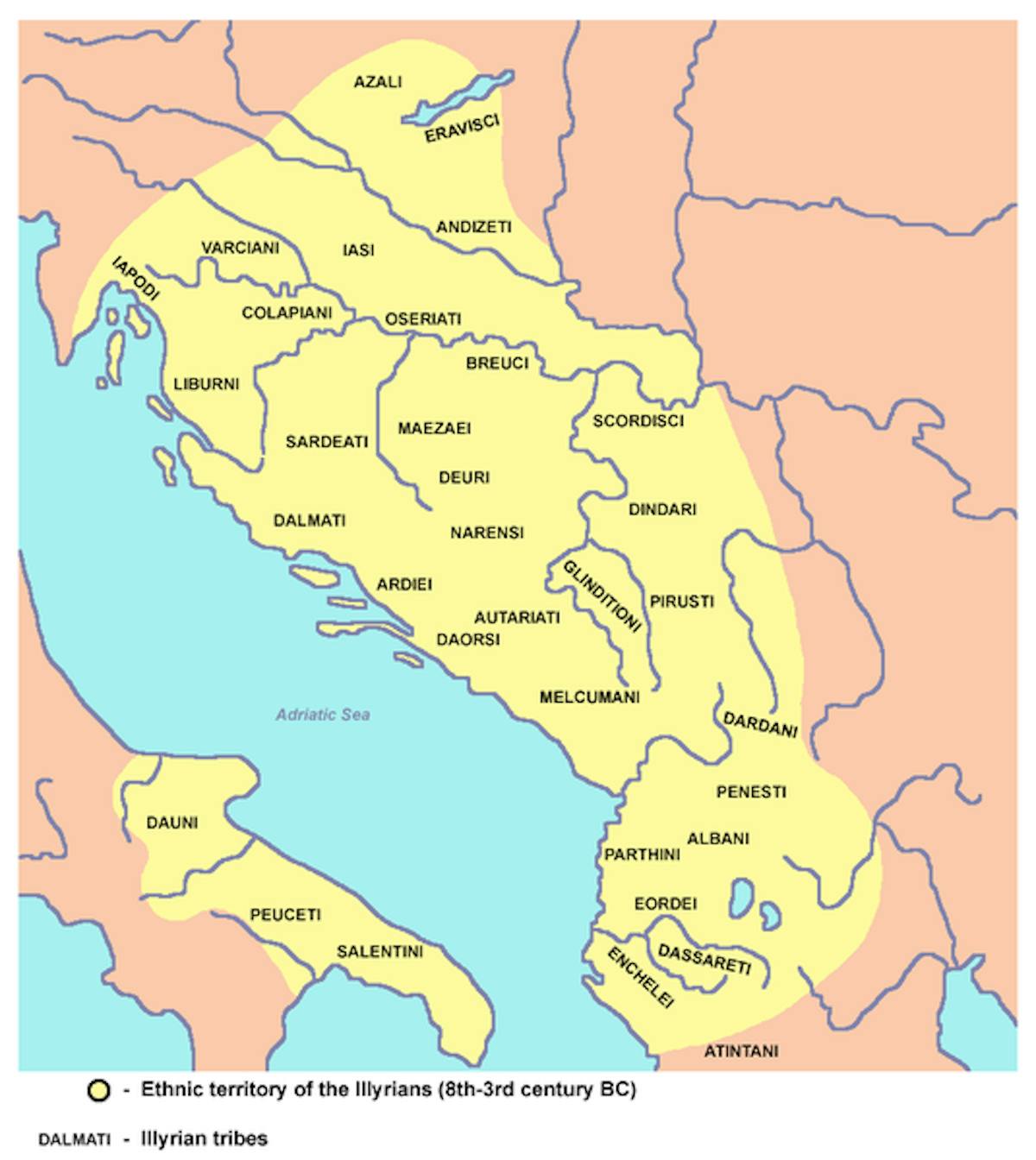What is the Origins of the Illyrians and the Albanians?
 Arberian 10/05/2024
Arberian 10/05/2024 
The Albanians were firstly recorded in the 11th century, while that doesn't that doesn't mean they were newcomers in the Balkans.[1]

The Yamnaya migrants, originally from what is now Ukraine and Russia, moved into the Balkans around 2500 BC. This migration gave rise to the Proto-Illyrians, who later intermixed with European Hunter-Gatherers and, to a lesser extent, Western Hunter-Gatherers, eventually forming the Illyrian people.

This was the HG & Farmer admixture among some Illyrians:




The Illyrians carried mostly the Haplogroups R1b-Z2103 J2b-L283 and E-V13 at a lower extent, most likely that E-V13 came from the Dardanians which could have been of distant male Thracian Origin.
Patterson et al. 2022 study examined 18 samples from the Middle Bronze Age up to Early Iron Age Croatia, which was part of Illyria. Out of the nine Y-DNA samples retrieved, which coincide with the historical territory where Illyrians lived (including tested Iapodian and Liburnian sites), almost all belonged to the patrilineal line J2b2a1-L283 (>J-PH1602 > J-Y86930 and >J-Z1297 subclades) with the exception of one R1b-L2. The mtDNA haplogroups fell under various subclades of H, H1, H3b, H5, J1c2, J1c3, T2a1a, T2b, T2b23, U5a1g, U8b1b1, HV0e.[2]
In Lazaridis et al. (2022) key parts of the territory of historical territory of Illyria were tested. In 18 samples from the Cetina culture, all males except for one (R-L51 > Z2118) carried Y-DNA haplogroup J-L283. Many of them could be further identified as J-L283 > Z597 (> J-Y15058 > J-Z38240 > J-PH1602). The majority of individuals carried mtDNA haplogroups J1c1 and H6a1a. The related Posušje culture yielded the same Y-DNA haplogroup (J-L283 > J-Z38240). The same J-L283 population appears in the MBA-IA Velim Kosa tumuli of Liburni in Croatia (J-PH1602), and similar in LBA-IA Velika Gruda tumuli in Montenegro (J-Z2507 > J-Z1297 > J-Y21878). The oldest J-L283 (> J-Z597) sample in the study was found in MBA Shkrel, northern Albania as early as the 19th century BCE. In northern Albania, IA Çinamak, half of them men carried J-L283 (> J-Z622, J-Y21878) and the other half R-M269 (R-CTS1450, R-PF7563). The oldest sample in Çinamak dates to the first era of post-Yamnaya movements (EBA) and carries R-M269.[2]
While the oldest Balkan J-L283 samples have been found in final Early Bronze Age (ca. 1950 BCE) site of Mokrin in Serbia and about 100–150 years later in Shkrel, northern Albania.[3][4]
- Now how did the Albanians descend from the Illyrians when they only appear in the 11th century?
The Albanians weren't such thing during the Byzantine era, but were called Illyriciani, and spoke Latin and Greek as being under the Roman and Byzantine Empire, but somehow, some Illyrians did not get romanised despite being under Roman rule, and re-formed the Illyrian race into an "Arberor" one, later called Albania by the Romans.





Now that acknowledge how the Albanians were formed, let's take a look on their Genetic makeup

We can see that the Genome of these Albanians from Tirana is mostly Illyrian, while they're pretty different from other Albanian results, which would likely score a bit more Illyrian.
Let's take a look at Albanians on G25.

(G25 average Albanian samples Here)
The average is 74% Illyrian, 14% Slavic an 10% Anatolian, which is pretty much Illyrian to be considered as such.
The difference between Northern Albanians is that they have more Slavic admixture while the Southerns have less, and the opossite goes for Anatolian admixture, while we find that the most pure Albanians are found in Mirdite and Chameria, as having the most Illyrian DNA.
But what about Haplogroups? Haplogroups indicate paternal lineage but do not provide information about genetic admixture or the percentage of your autosomal DNA. For example, if an Albanian man with the E-V13 haplogroup has a child with a South Slavic woman (which has already a part of Paleo-Balkan admixture), and their child later has a child with an Albanian woman, the presence of Slavic DNA in the offspring is clear from the maternal line, despite the paternal haplogroup remaining E-V13.
Here's what happens if the process i explained happens:

These are the Haplogroups found among Albanians as according to Rrenjet:

And here are some Iron Age Illyrian Haplogroups among Albanians found in Ancient sites in Albania, Montenegro, N.Macedonia, Croatia and more:




And here's some Roman period Illyrian clades among Albanians:


While here's a Medieval Albanian belonging to T1a, most likely of foreign origin that could belong to people the Easty of the Mediterran, such as the Phoenicians.

If these Albanians are descended from specific subclades identified in the limited Illyrian samples we currently have, just imagine how many more Albanians—many of whom remain untested—could also be descended from those Illyrians, or from other samples that have yet to be discovered.
However, Albanians aren't solely defined by their DNA, so they can't be considered purely Illyrian just because they carry certain genetic markers. Their identity has evolved from the Roman period, tracing back to the Illyrians and eventually to modern Albanians, as I've explained before. This evolution is also reflected in numerous cultural elements shared with the Illyrians, such as the Opinga, Xhubleta, Pileus, Fustanella, and their language. Additionally, the Kanun, like the one codified by Lek Dukagjini, bears similarities to the societal structure of the Illyrians.


Which we also can see by "all" those Messapic and Illyrian words found alive still in the Albanian language.

About Arberian
An Albanian, interested in history and genetics.